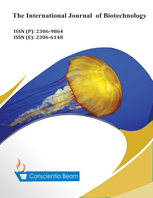Antimicrobial Activities of Garlic and Ginger Extracts on Some Clinical Isolates
DOI:
https://doi.org/10.18488/journal.57.2019.81.59.65Abstract
The antibacterial activity of n-hexane and methanol extracts of ginger and garlic was determined in vitro against Escherichia coli, Salmonella enterica, Klebsiella pneumoniae and Shigella dysenteriae using agar well diffusion technique. The phytochemical screening revealed the presence of flavonoids, saponins, carbohydrates, alkaloids and triterpenes in the plant extracts. The n-hexane and methanol extracts of garlic were observed to be more potent against S. dysenteriae with maximum zone of inhibition of 27 mm at 40 mg/ml and 29 mm at 80 mg/ml. The n-hexane and methanol extracts of ginger were observed to be more potent against E. coli with maximum zone of inhibition of 16 mm at 40 mg/ml and 19 mm at 80 mg/ml. The MIC of the methanolic extract against the test organisms was determined to show values between 5 and 20 mg/ml. In comparison, the n-hexane extract had MIC values between 2.5 and 10 mg/ml. The methanol extract of ginger had MIC values between 10 and 40 mg/ml while the n-hexane had MIC values between 10 and 20 mg/ml. The MBC of methanol garlic extract was between 10 and 40 mg/ml. The n-hexane garlic extract had MBC values between 2.5 and 20 mg/ml. The methanol extract of ginger had MBC values between 10 and 40 mg/ml while the n-Hexane ginger extract had MBC values between 10 and 20 mg/ml. The result of this study showed that the extracts had activity against the test organisms and as such could be used for drug development.

